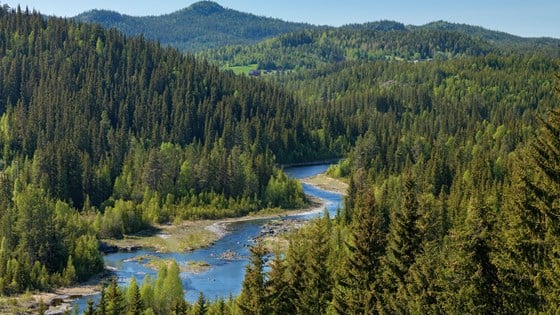Forestry
Article | Last updated: 03/12/2014 | Ministry of Agriculture and Food
The potential for increased value creation is large.Forestry policy must facilitate sustainable resource management, where harvesting does not exceed the regrowth rate, and take into account other essential functions of forests - as wildlife habitat, recreational arena for people, and as storage and sinks of carbon.

Forest industry is important to Norway. Active and profitable forestry and a competitive forest industry is of importance for settlement, employment and business development in large parts of the country. The potential for increased value creation is large.
Forests cover about 38 percent of Norway's land area, or about 122.000 square kilometers. Of this, around 86.600 square kilometers are productive forests - that is, they produce enough timber to be important for forestry. In total, Norway today has almost 11 billion trees of 5 cm or more in diameter.
Forestry is an industry practically all over the country. The main tree species by volume and economic importance are spruce, pine and birch. Hedmark is Norway's largest forest county.
More and more raw materials
Norwegian forest owners have a long and successful tradition of sustainable management of forest resources.
When felling timber, forest owners in Norway are required to promote the regrowth of new forest - either by planting, or by leaving seed trees to provide natural regeneration.
Norway was first in the world to map the relationship between density and regrowth - as early as 1919.
The volume of raw material in the forests of Norwy is measured in cubic meters of timber without bark.
After a long period of steady commercial extraction, the timber volume in Norwegian forests has tripled over the past 100 years - from 300 million cubic meters in 1919 to about 900 million today. The trees have become taller and the forests denser - and they cover an area larger than ever before.
This positive trend continues. On average, Norwegian forests increase by about 25 million cubic meters of timber per year. Spruce accounts for half of this growth. Every year about ten million cubic meters of timber are felled.
It is not only industrial timber that increases. National parks and forest reserves, too, make up an increasing proportion of the forest area in Norway.
Important Industry
Forestry is a traditional and important industry in Norway. It provides jobs and export earnings. Around 25.000 people are employed in the forest-based value chain.
Norway is among the leaders in the world when it comes to innovation and new applications of forest-based raw materials - which today includes everything from building materials to bioenergy and processed raw materials such as lignine and cellulose, an ingredient in many products found in any ordinary household.
The potential for increased value creation is large. The forest industry adds more than tenfold to the value of the log as it is processed. Wood is also a renewable resource, which in many cases can replace petroleum-based raw materials.
Forestry and forest industries are part of an unprotected world market and are subject to global market developments.
Norwegian forest policy must lay the foundation for sustainable management of forest resources, taking into consideration important environmental values and all the species that live in the forests and rangelands. Biodiversity is best served by a combination of conservation and sustainable use.
The goal is increased value through facilitating increased production of timber, bioenergy and other products and services related to forestry.